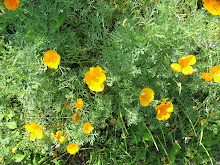The hardest aspect of this day, at least for me, is to choose one poem to have the honor to share space with my keys, spare change, and lint. This year, with the blog in mind, my choice addresses a gardening theme. I have decided to go with "The Garden Gate" (see below), though a little web research has dug up a few contenders, including:
"Guests" by Celia Thaxter--she captures the sensory essence of gardening, not just through her poetry, but through other written reflections about her own experiences tending an amazing garden on an island off the coast of Maine. More from her in future posts...
"They'll spend the summer" by Joshua Beckman--a sweet little haiku leaving the reader wondering who "they" are. My guess is that they are people like you and me and the garden alleviates our stress.
"The Glory of the Garden" by Rudyard Kipling--a decent garden takes hard work. Though I object to the poet's suggestion that only men carry out these duties, I'll acknowledge just a little that he was a product of his time.
"My Garden" by Emily Dickinson--though vulnerable, the garden will always be a place for birth.
If anyone out there has another notable poem within this theme, please share it. "The Garden Gate," written in February by Joe Bergin and Terry McAweeney, is a thoughtful tribute to the Minton Stable Garden and the people who have made it a special place. Joe has read the poem twice, at the Sounds of the Garden benefit and the Gardeners Gathering, but to our knowledge, it has not had its Internet debut, until now:
The Garden Gate
You get up early in spring in the morning
The riotous birds are mating high handsome and wide
The early light has beamed through your bedroom window
You trip down the steps to the great outside
Crocuses at your foot, the promise of a daffodil
The breeze doesn't bite, and the garden gate defrosted
is in a stone's throw sight
and in your bones you feel the old thrill
You've studied the January seed catalogues
You've sent for the heirloom strains
You've consulted the Farmer's Almanac
You've prayed for a sunny May and a tapering off of April rains
It's a short march to the garden
A shovel and hoe in hand
to turn the soil, put your back into toil
and your time and energy to sweeten the land
On your walk down the radius gravel path
you pause by the 3 granite monuments to the man
and give a thought to old John Carroll
and think to yourself
just how this glorious garden began
It was back in 1993
after they tore down the ancient horse barn
John, who'd seen much death in Vietnam
looked across the overgrown vacant city lot
and in a vision saw a neighborhood flower and vegetable farm
And you know he knew that was the old horse trail
where pleasure riders into Franklin Park would prance
and his mind must've reeled at the sheer infinitude of biomass
of all the equine road apple gifts
that down through the years
became the rich land grant of nitrogen to our plants
Now, onward, you open the wooden and iron ball and chain gate
and proceed to your 10' by 10' plot
The sun is kissing the back of your neck
and you feel sweetly high as if you've just had a large chocolat
Turn the soil, add compost, look for earthworms
Level the land, sow the seeds, hum a song
Thank Mother Earth, say a prayer to your little garden
May miraculous germination
please not take very long
Say, there's your beloved neighbor!
You converse as you're down on all fours
You delight in airy conversation
as they till their soil on their plot down from yours
It's a model for communities everywhere
It makes a hamlet of our corner of Jamaica Plain
Where you work side by side with fellow gardeners
growing crops in the sun and the rain
So it is, come summer, down on Williams Street
Home from work, ask a neighbor how their day has gone
and you can tell it's been a hard one
...but they smile and say
"I'll see you in the garden, later on..."













